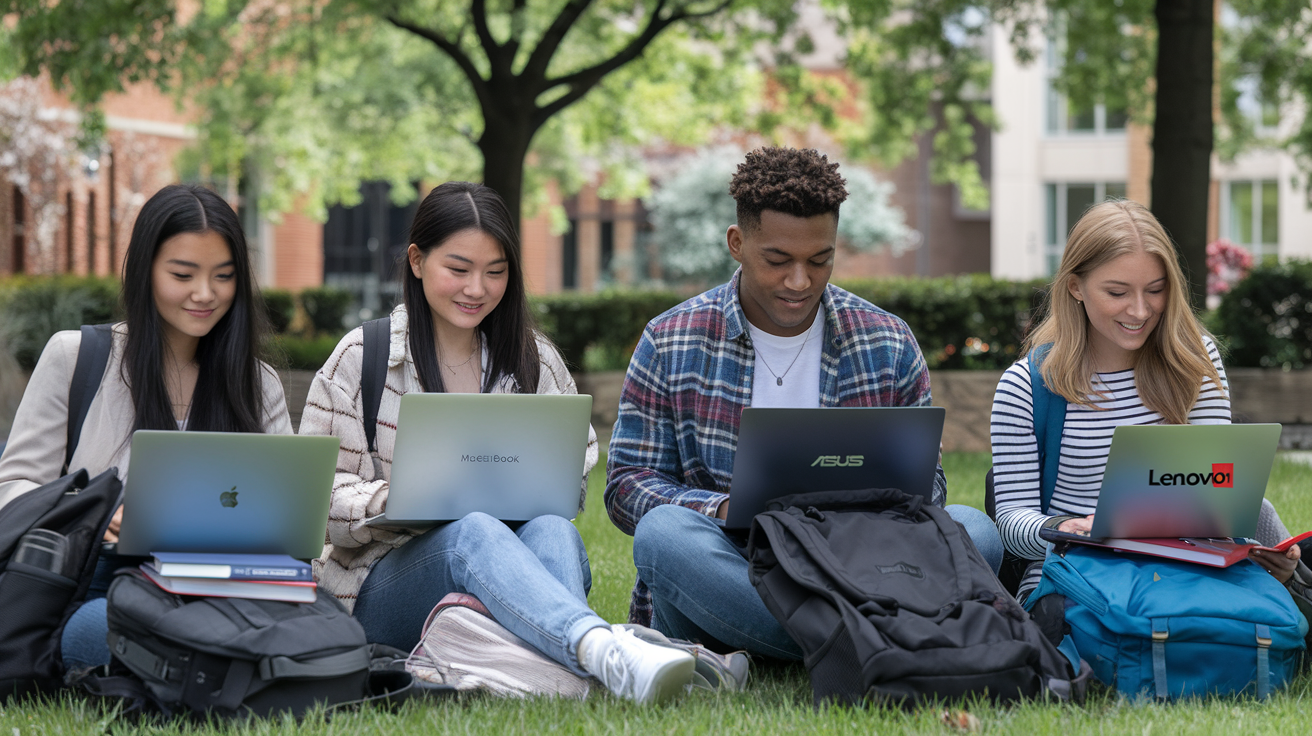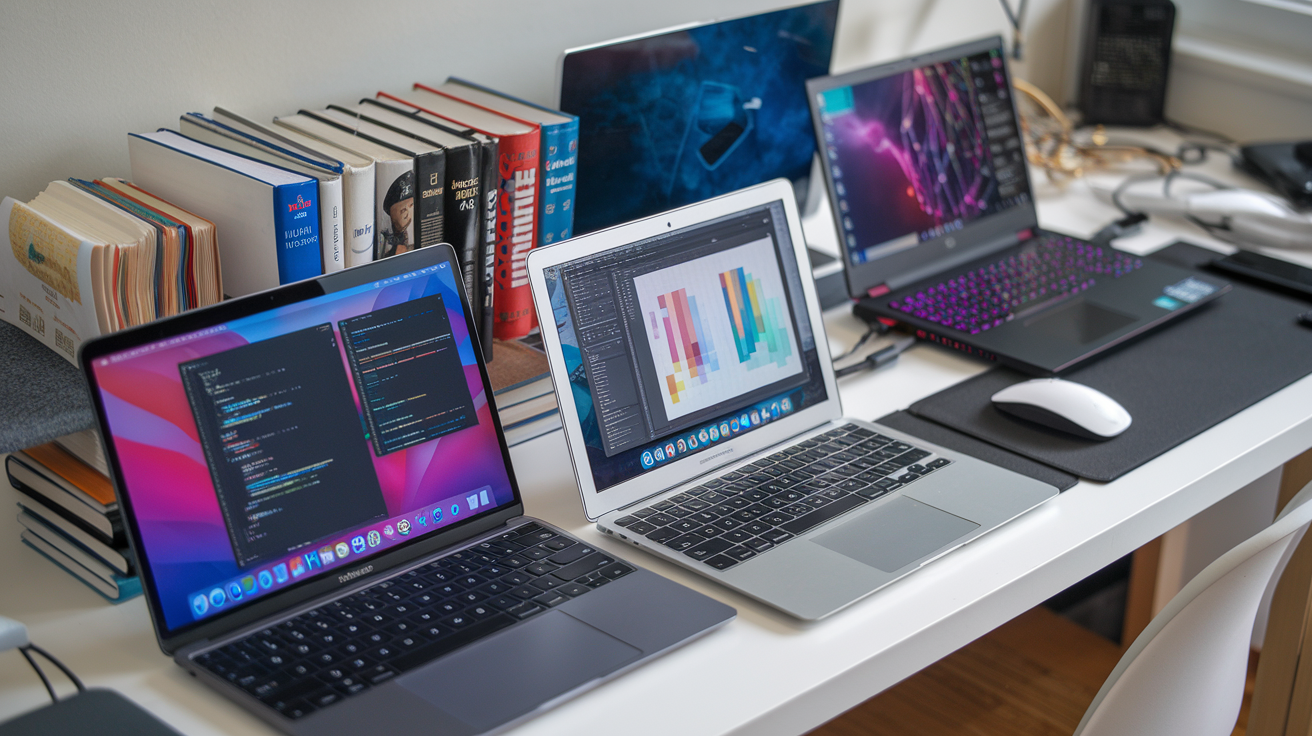Laptops for Students: Boost productivity with 7 best picks, featuring fast processors, long battery life, and top performance for effortless learning in May 2025. These laptops for students are designed to enhance your academic journey.
Table of Contents
Laptops for Students: 7 Smart Picks for Success (May 2025)

Laptops for Students: 7 Smart Picks for Success (May 2025)
The right laptops for students can transform your academic experience, providing the tools needed for success. Whether you are taking notes in class or collaborating on group projects, these laptops for students will help you stay organized and productive.
In today’s fast-paced academic environment, a reliable laptop isn’t just a luxury—it’s an essential tool for success. As students navigate between lectures, study sessions, and dorm life in 2025, having the right device can make all the difference in managing coursework, research, and creative projects. But with countless options flooding the market—from budget-friendly Chromebooks to premium powerhouses with OLED displays—finding the perfect balance of performance, portability, and price can feel overwhelming.
When choosing laptops for students, consider factors such as weight, performance, and battery life. A good laptop can be the difference between success and struggle in your studies.
With the right laptop for students, you can tackle digital assignments, research projects, and creative tasks without the stress of technical issues.
Explore various laptops for students that balance performance and price, allowing you to excel at your studies without overspending.
Why struggle with outdated technology or overspend on features you don’t need? The latest generation of student laptops offers impressive battery life exceeding 15 hours, lightning-fast processors, and specialized features tailored to different academic paths. Whether you’re a creative arts major needing robust graphics capabilities, an engineering student requiring processing power, or simply working within a tight budget, our comprehensive guide breaks down everything you need to know to make an informed decision. 💻✨
Investing wisely in laptops for students will allow you to excel in your studies, engage in creative projects, and manage your coursework effectively. These laptops for students cater to various needs and budgets, ensuring there’s an option for everyone.
In conclusion, the right laptops for students can significantly influence your academic success.
In 2025, the demand for laptops for students has never been higher. With advancements in technology, students can now choose from a range of devices that support their academic and extracurricular pursuits.
In this guide, we’ll explore why having a quality laptop matters in 2025’s digital classrooms, key factors that should influence your purchase decision, and our top recommendations across various categories—from best overall performers to budget-friendly options that don’t compromise on essentials. We’ll also share insider tips on scoring student discounts and making the most cost-effective choice for your unique needs.
GPT: I’ve created an engaging introduction for the blog post about student laptops. I used the PAS (Problem-Agitate-Solution) framework to highlight the challenge of selecting the right laptop, then agitated the problem by mentioning the overwhelming options, and finally offered the solution through the blog guide. I incorporated formatting with bold text and emojis where appropriate, and ended with a smooth transition into the main points covered in the blog outline.
Why Students Need a High-Quality Laptop in 2025

Essential tool for transitioning between classes and dorm life
Selecting the best laptops for students involves understanding various factors such as performance, battery life, and price. Ensuring you pick the right laptop for students will set the foundation for your academic journey.
With so many choices available, narrowing down the best laptops for students based on your needs is essential. Look for models that offer a combination of performance, portability, and price to find the ideal laptop for students.
Each major comes with its own set of requirements, making it crucial to choose laptops for students that cater specifically to your field of study. Consider the software you’ll use and look for laptops for students that can handle those demands.
Gone are the days when a laptop was just a nice-to-have for students. In 2025, it’s as essential as your student ID.
Think about your typical day: morning lectures, afternoon study sessions at the library, evening group projects in the common room, and late-night essay writing in your dorm. Your laptop needs to follow you everywhere without complaint.
The best laptops for students in 2025 aren’t just devices—they’re lifelines. When you’re rushing between classes across campus, that extra pound of weight matters. When your battery dies mid-lecture, that’s notes you’re missing. When your laptop crashes before saving that 10-page paper? Well, let’s not even go there.
Modern college life demands tech that can keep up. Most professors now distribute materials digitally, require online submission of assignments, and expect you to participate in virtual discussions. Without reliable tech, you’re starting the semester at a disadvantage.
It’s crucial to understand the key features to look for in the best laptops for students—including processing power and battery life.
Balance between performance, affordability, and durability
Here’s the tricky part about student laptops—they need to be affordable yet powerful enough to last your entire degree program.
The sweet spot for budget laptops for school in 2025 sits between $600-900. Go cheaper, and you’ll likely be shopping for a replacement before junior year. Go more expensive, and you might be eating ramen for an extra month.
Investing in the right laptop for students will ensure you are prepared for any academic challenge.
What matters most in student laptop comparison for 2025?
| Feature | Why It Matters |
|---|---|
| Processor | Handles multitasking between research, writing, and Netflix |
| Battery life | Lasts through your longest day without hunting for outlets |
| Build quality | Survives backpack bumps and occasional coffee spills |
| Weight | Your back will thank you after carrying it all day |
Different majors have different demands too. Engineering students need processing power for simulation software. Art majors need color accuracy and stylus support. Business students need reliability for presentations. The specialized laptops for college majors have never been more diverse.
Benefits of portability compared to desktop computers
Desktop computers have their place, but college life demands mobility.
The average student changes locations 5-7 times daily. Lugging a desktop between your morning class, the library, coffee shop study session, and back to your dorm isn’t happening.
Portable laptops give you:
- Freedom to study wherever you focus best
- Ability to collaborate in person with study groups
- Option to take notes directly in class
- Flexibility to visit home without losing access to your work
For students involved in creative majors, certain laptops for students provide the necessary tools for design and video editing.
High-performance student computers no longer mean sacrificing portability. Even powerful machines for video editing or gaming now come in surprisingly lightweight packages.
Remember, your laptop is your academic command center for four years. Choose wisely, and it becomes your most valuable educational investment besides tuition itself.
When selecting laptops for students, prioritize features that enhance your learning experience. From lightweight designs that are easy to carry to powerful processors that handle demanding tasks, the right laptop for students can make a significant difference.
Key Factors to Consider When Choosing a Student Laptop

Weight and portability for daily campus mobility
College life means constantly being on the move. You’re rushing from dorm to class, class to library, and library to coffee shop. The last thing you need is a laptop that feels like a brick in your backpack.
Most students find laptops under 4 pounds to be the sweet spot. Anything heavier and your shoulders will be screaming by midterms. Ultrabooks like the Dell XPS 13 or MacBook Air (both around 2.8 pounds) are perfect campus companions.
But here’s the catch – don’t just focus on weight. Consider the overall dimensions too. A compact 13-inch laptop might fit better in crowded lecture halls where desk space is basically non-existent.
Processing power needs (Intel vs AMD recommendations)
Your major basically dictates how much processing muscle you need. For most students taking notes and writing papers, you don’t need a powerhouse.
For general studies and business majors:
- Intel Core i5 (12th gen or newer)
- AMD Ryzen 5 (5000 series or newer)
These will handle multiple browser tabs, Zoom calls, and standard productivity apps without breaking a sweat.
For engineering, design, or computer science students:
- Intel Core i7/i9 (12th gen or newer)
- AMD Ryzen 7/9 (5000 series or newer)
These chips can tackle demanding software like CAD programs or coding environments.
The AMD vs Intel debate? AMD typically offers more cores for less money – great for multitasking on a budget. Intel still edges ahead in single-core performance, which matters for some specific applications.
Storage requirements (minimum 512GB SSD)
SSDs have completely changed the laptop game. They’re blazing fast compared to old hard drives, and they’re more durable for students constantly moving around.
512GB is now the minimum you should consider for 2025. Four years of projects, presentations, and personal files add up quickly. Education software is getting bigger every year.
Cloud storage helps, but you’ll still want local storage for:
- Large project files
- Software installations
- Media collections
- Working offline when campus Wi-Fi inevitably crashes
If budget is tight, 256GB might work if you’re disciplined about cloud storage and external drives, but you’ll likely regret it by sophomore year.
Battery life expectations (10+ hours ideal)
Nothing’s worse than the mid-lecture battery panic when all the wall outlets are taken.
For 2025, don’t settle for anything less than 10 hours of real-world battery life. Manufacturers love to claim 15+ hours, but those numbers rarely hold up in actual use.
The best student laptops now offer:
- 12-15 hours of web browsing
- 10-12 hours of video playback
- 8-10 hours of more intensive work
Fast charging is also worth looking for – the ability to get 50% battery in 30 minutes can be a lifesaver between classes.
Operating system preferences (Windows, macOS, Chrome OS)
Your OS choice affects everything from software compatibility to workflow.
Windows remains the most versatile option. It runs virtually all educational software, offers the widest range of laptop options at every price point, and dominates in the gaming department for after-study hours.
MacOS shines for creative majors. The ecosystem integration is unmatched if you already have an iPhone. Macs typically last longer than their Windows counterparts, potentially making them better investments despite higher upfront costs.
Chrome OS is the budget-friendly option that’s evolved beyond just browsing. Chromebooks now support Android apps and some even run Linux applications. Perfect for students who primarily work in the cloud and want great battery life.
Best Overall Laptops for Students

Asus Zenbook 14 OLED Touch: Perfect balance of features
Look, finding a laptop that does everything well without breaking the bank isn’t easy. But the Asus Zenbook 14 OLED Touch nails it for 2025.
Why does it top our list? This baby packs a punch with the latest 14th-gen Intel Core i7 processor and 16GB of RAM, handling everything from research papers to design projects without breaking a sweat. The 14-inch OLED touchscreen is honestly game-changing for students—colors pop like crazy, and the touch functionality means you can annotate notes or sketch diagrams directly on screen.
Battery life? You’re looking at 12+ hours of actual use. Not manufacturer fantasy numbers, but real-world performance. Forgot your charger at home? No panic attacks necessary.
At just 2.8 pounds with a slim profile, it slides into your backpack without giving you shoulder pain. The backlit keyboard is surprisingly comfortable for those inevitable all-nighters.
Priced at around $999 with student discounts, it’s not the cheapest option, but the value is undeniable. For a laptop that’ll see you through your entire degree program, that’s money well spent.
MacBook Air M3: Exceptional battery life and performance
The Apple tax is real, but there’s a reason MacBooks dominate campus libraries. The 2025 M3 MacBook Air is ridiculous in the best possible ways.
The M3 chip is plain unfair to the competition. It chews through intensive tasks while barely sipping power. Students in video production, 3D modeling, or data science will appreciate the muscle without the weight or fan noise of traditional powerhouse laptops.
The battery life is flat-out stupid—20+ hours of real-world use. Charge it Monday morning and potentially get through Wednesday without sweating.
The 13.6-inch Liquid Retina display makes everything look crisp, and the keyboard is a dream for typing term papers. The ecosystem integration with iPhones and iPads is clutch for many students.
Starting at $1099 (with education pricing), it’s pricier than Windows alternatives. But if you’re deep in the Apple ecosystem already or need something that just works without drama, this is your pick.
Acer Aspire 5: Affordable option with solid build quality
College is expensive enough. The 2025 Acer Aspire 5 proves you don’t need to drop a grand for a capable student laptop.
For around $629, you get a 12th-gen Intel Core i5, 8GB RAM (upgradeable), and a 15.6-inch Full HD display. It handles day-to-day coursework, research, and even light photo editing without complaint.
The build quality stands out at this price point—no creaky plastic or flimsy hinges here. The keyboard is surprisingly good for the price, with decent travel and a numeric keypad that math and finance majors will appreciate.
Battery life hits about 8 hours of real-world use—enough for a full day of classes if you’re not gaming between lectures.
Bonus points for ports: HDMI, USB-C, multiple USB-A, and Ethernet mean no dongles needed for presentations or wired connections.
Is it as sleek as the ZenBook or powerful as the MacBook? Nope. But it’s honest, reliable hardware that gets the job done without emptying your savings account. For budget-conscious students, it’s a smart investment that’ll easily last through graduation.
Best Budget-Friendly Options

Lenovo IdeaPad Flex 3 Chromebook: Durable with great battery
Look, college life is tough on tech. Your laptop gets stuffed in backpacks, used in coffee shops, and sometimes stays up longer than you do. That’s where the Lenovo IdeaPad Flex 3 Chromebook shines as one of the best budget laptops for students in 2025.
This little workhorse starts around $329 – seriously budget-friendly when you’re already drowning in textbook costs. But don’t let the price fool you. The battery life? Phenomenal. We’re talking 10+ hours on a single charge, which means you can camp out at the library all day without hunting for an outlet.
The 360-degree hinge lets you flip it into tablet mode for reading or tent mode for Netflix study breaks (we all need them). It’s compact and lightweight at just 2.6 pounds – your spine will thank you after lugging it around campus all day.
For most students taking notes, writing papers, and doing research online, ChromeOS is perfectly capable. The Intel Celeron processor handles basic multitasking just fine, though it might struggle with heavy-duty design work or engineering programs.
Is it perfect? Nope. The 4GB RAM won’t win any performance awards. But for the price point and what most students actually need? It’s solid.
MacBook Air M1: Still powerful at a lower price point
The 2020 M1 MacBook Air is still crushing it in 2025, and here’s why: Apple’s older models often become the best laptop deals for students once newer versions push down their prices.
Now hovering around $799 during student sales (down from its original $999), it’s become genuinely affordable while still packing serious performance. The M1 chip utterly embarrasses similarly priced Windows laptops in both speed and battery life.
What makes it perfect for college life? First, that ridiculous 18-hour battery life. Second, it weighs just 2.8 pounds but feels solid enough to survive four years of campus chaos. And that fanless design means complete silence during late-night study sessions.
For most college majors – yes, even photo editing for that communications class – the M1 handles everything smoothly. Sure, the newer M3 or M4 might be faster, but do you really need that extra power for writing papers and making presentations? Probably not.
The biggest drawback? Just two USB-C ports. You might need a dongle or hub for connecting multiple devices.
Acer Swift Go 14: Performance without breaking the bank
When you need Windows for specific programs but still want to keep costs reasonable, the Acer Swift Go 14 hits that sweet spot at around $649.
This laptop packs an Intel Core Ultra processor with onboard AI features that actually help with battery optimization and background task management – practical stuff, not just marketing fluff. For students balancing multiple applications between classes, this makes a real difference.
At 3.1 pounds, it’s still backpack-friendly while offering a gorgeous 14-inch 1080p display that makes textbook diagrams and study guides crystal clear. The keyboard has decent travel – important when you’re typing 20-page research papers at 2 AM.
The 16GB RAM configuration handles multitasking like a champ, even with multiple browser tabs, Spotify, and productivity apps running simultaneously. That’s crucial during finals week when you’re bouncing between research sources.
Battery life hits about 8-9 hours of real-world use – not record-breaking but enough to get through a full day of classes without panic-searching for an outlet.
Specialized Laptops for Different Student Needs

A. Best 2-in-1 convertibles: Lenovo IdeaPad Flex 5i and Dell Inspiron 14
College life demands flexibility, and that’s exactly what these 2-in-1 laptops deliver. The Lenovo IdeaPad Flex 5i sits at the sweet spot between performance and affordability. At $649, you’re getting a machine that transforms from laptop to tablet in seconds.
What makes the Flex 5i stand out? The 13th-gen Intel Core i5 processor handles multiple browser tabs, Word docs, and Zoom calls without breaking a sweat. The 14-inch touchscreen display (1920 x 1080) is perfect for note-taking with the included stylus. Battery life stretches to about 10 hours—enough for a full day of classes.
The Dell Inspiron 14 2-in-1 ($799) edges ahead with slightly better build quality. The aluminum chassis feels premium, and the keyboard is more comfortable for marathon typing sessions. Its 14-inch display offers better color accuracy (98% sRGB coverage), making it ideal for students who occasionally edit photos or videos.
Both laptops include:
- 8GB RAM (upgradable to 16GB)
- 512GB SSD storage
- WiFi 6 connectivity
- Windows 11
The main difference? The Dell offers a faster processor and better display, while the Lenovo wins on price without sacrificing much performance.
B. Top picks for creative students: Apple MacBook Air M3
Creative majors need serious horsepower, and the MacBook Air M3 delivers. Starting at $1,099 (with student discount), it’s not cheap, but trust me—it’s worth every penny for design, film, or photography students.
As you explore options for laptops for students, remember that investing in a reliable, high-quality device can enhance your learning experience and academic performance.
The M3 chip absolutely crushes anything in this price range. It handles Adobe Creative Suite applications like they’re nothing—even when working with large Photoshop files or editing 4K video. The 8-core CPU and 10-core GPU combination delivers performance that used to require a much bulkier machine.
Finding the right laptop for students can enhance your college experience, making it easier to manage coursework and extracurricular activities.
The 13.6-inch Liquid Retina display (2560 x 1664) shows colors accurately with 100% P3 color gamut coverage—crucial for creative work. And with 18+ hours of battery life, you can edit all day without hunting for an outlet.
Other standout features include:
- 8GB unified memory (16GB recommended for serious creative work)
- 256GB SSD (consider upgrading)
- Excellent built-in speakers and microphones
- MagSafe charging
C. Gaming-capable options: MSI GF63 Thin and Lenovo Legion Pro 7i
Gaming laptops pull double duty for students—powerful enough for class projects and capable of running the latest games.
The MSI GF63 Thin ($899) is perfect for casual gamers on a budget. With its NVIDIA GeForce RTX 4050 GPU and Intel Core i5-12450H processor, it handles esports titles like Valorant or Overwatch 2 at high settings, while maintaining decent frame rates on AAA games at medium settings.
For serious gamers, the Lenovo Legion Pro 7i ($1,599) is worth the splurge. The RTX 4070 GPU and 13th-gen Core i7 processor tear through demanding games and resource-intensive applications like 3D modeling software.
Both offer:
- 16GB RAM
- 512GB SSD (expandable)
- High refresh rate displays (144Hz+)
- RGB backlit keyboards
Remember though—gaming laptops typically have shorter battery life (4-6 hours) and weigh more than standard student laptops. The MSI is lighter at 4.1 pounds, while the Legion Pro 7i tips the scales at 5.5 pounds.
Smart Ways to Save on Your Laptop Purchase

University-specific student discounts
College tuition is already breaking the bank, so why pay full price for a laptop? Most major computer brands offer sweet student deals that can save you hundreds.
Dell, Apple, Microsoft, and HP all run education stores with discounts ranging from 10-20% off retail prices. Apple’s education pricing might save you $100-200 on a MacBook, while Dell often throws in extra perks like extended warranties or free accessories with their student deals.
The key is verifying your student status. Usually, all you need is your .edu email address or a student ID through verification services like UNiDAYS or SheerID.
Don’t forget about your specific university’s tech store! Many colleges have partnerships with manufacturers offering deeper discounts than you’ll find online. For example, some engineering programs have special pricing on high-performance laptops that can handle CAD software.
Pro tip: These discounts typically refresh around July/August for back-to-school season. If you can wait until then, you’ll likely score the best laptop deals for students 2025 has to offer.
Evaluating warranty options vs. potential repair costs
That warranty upsell at checkout might actually be worth it. Here’s the deal: laptop repairs are expensive. A simple screen replacement can cost $300+, while motherboard issues might run $500+.
Standard manufacturer warranties (typically 1 year) cover manufacturing defects but not accidents. For students carrying laptops across campus daily, that’s a problem.
| Coverage Type | Average Cost | What It Covers | Worth It For |
|---|---|---|---|
| Basic Warranty | Free (1 year) | Manufacturing defects | Everyone |
| Extended Warranty | $100-300 | Same as basic, longer term | High-end laptops |
| Accidental Protection | $50-200/year | Drops, spills, breaks | Most students |
For budget laptops for school under $500, expensive protection plans often don’t make financial sense. But for $1000+ machines, spending $150 on coverage that includes accidental damage is smart math.
Many credit cards offer extended warranty protection when you purchase with their card – a free way to get an extra year of coverage.
Free or subsidized laptop programs through educational institutions
Your college might literally give you a free laptop. No joke.
Many schools now include laptops in tuition or offer them through grant programs. Schools like Southern New Hampshire University and Wake Forest University provide laptops to all incoming freshmen.
Other institutions offer laptop loan programs where you can borrow a computer for a semester or the entire academic year. Perfect if your budget is super tight.
Financial aid can also cover laptop purchases. If you receive federal student aid, that money can legally be used for “education-related equipment” – including a computer. Talk to your financial aid office about including a laptop in your cost of attendance calculation.
Some academic departments have their own laptop programs for specific majors. Computer science, design, and engineering departments often provide specialized laptops for college majors with demanding software requirements.
Making the Final Decision

Matching laptop specifications to your specific major or program
Look, picking a laptop for college isn’t one-size-fits-all. Your major basically dictates what you need.
Art and design students? You’ll want that color-accurate display, hefty RAM, and a discrete GPU that won’t choke when rendering your 3D models or video projects. The MacBook Pro or Dell XPS 15 might cost more, but they’re workhorses that’ll handle Adobe Creative Suite without breaking a sweat.
Engineering or computer science? Processing power is your best friend. Get something with at least an Intel i7 or AMD Ryzen 7, 16GB RAM minimum, and solid thermal management. The Lenovo ThinkPad P series or ASUS ROG laptops give you that computational muscle for running simulation software or compiling code.
Business majors can typically get by with mid-range specs – focus on battery life and portability since you’ll be moving between classes, group meetings, and internships. The MacBook Air or HP Envy are perfect here.
Humanities and social sciences? Don’t waste money on specs you’ll never use. A decent i5 processor, 8GB RAM, and good battery life will cover your research papers and endless browser tabs just fine.
Considering future-proofing vs. immediate budget constraints
The million-dollar question: spend more now or upgrade later?
Honestly, the sweet spot for most students sits in the $800-1200 range for 2025. Going cheaper often means replacing your laptop before graduation, while maxing out your credit card for premium features might be overkill.
Some specs worth splurging on:
- SSD storage (minimum 512GB)
- 16GB RAM (trust me, 8GB won’t cut it by junior year)
- Recent-gen processors (11th gen Intel or newer, AMD Ryzen 5000 series or newer)
What you can skimp on:
- Ultra-high resolution displays (1080p is plenty for most)
- Touchscreens (cool but rarely essential)
- Maximum storage (external drives are cheap)
Balancing premium features against practical everyday needs
Real talk: that gorgeous 4K OLED display? It drains battery life like crazy. That ultra-thin design? Often means terrible thermal management during finals week all-nighters.
Think about your actual student life:
- Will you be running between classes all day? Prioritize battery life and weight.
- Study in bright lounges or outdoors? Get a matte screen with good brightness.
- Live in a dorm with spotty Wi-Fi? Look for Wi-Fi 6 or 6E compatibility.
- Clumsy or always on the go? Durability matters more than premium materials.
Student laptop deals pop up regularly around back-to-school season, but don’t wait until August when everyone’s scrambling. The sweet spot for deals is May-June when manufacturers clear inventory for next year’s models.
Remember: the best laptop for college success isn’t necessarily the priciest – it’s the one that reliably does what YOU need for YOUR major without becoming a financial burden.

Making the Right Choice for Your Academic Journey
Choosing the right laptop is a critical decision that can significantly impact your academic success in 2025. Throughout this guide, we’ve explored options for every student need—from the versatile Asus Zenbook 14 OLED as our top overall pick to budget-friendly alternatives like the Lenovo IdeaPad Flex 3 Chromebook. Whether you need processing power for complex projects, portability between classes, or a balance of gaming and study capabilities, there’s a perfect match waiting for you.
Remember to consider the essentials: aim for at least 512GB SSD storage, processors that can handle your workload, battery life exceeding 10 hours, and a weight that won’t burden you across campus. Take advantage of student discounts through your university, and carefully evaluate warranty options against potential repair costs. With the right laptop by your side, you’ll be well-equipped to excel in your studies while enjoying the flexibility modern education demands. Make your investment count—your academic future depends on it.
Ultimately, the right laptops for students provide the support you need to succeed in your academic journey and beyond, making it essential to choose wisely.
Share this content:
